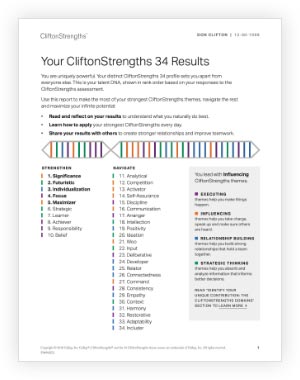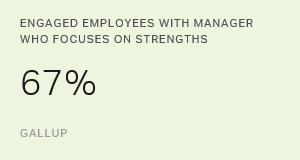Story Highlights
- A strengths-based approach transcends employee life cycle stages
- Boost engagement and other outcomes by focusing on CliftonStrengths
- Focusing on what employees do best is critical to performance development
Employee experience describes the journey an employee takes with your organization. It includes all the interactions your employees have with you before, during and after their tenure.
What happens during those interactions shapes your employees' perceptions of your organization -- which has an effect on employee performance, customer experiences and your ability to attract more talented employees.
Those interactions take place at various points in the employee life cycle: Gallup has identified seven life cycle stages during which employers have the opportunity to affect the employee experience the most.

One consistent approach to creating valuable interactions at each of the seven life cycle stages is focusing on employees' CliftonStrengths.
Long proven to be a driver of positive business outcomes, applying a strengths-based approach at each stage of the life cycle can ultimately result in an improved employee experience.
Here's how you can go deeper with CliftonStrengths at every stage of your employee experience strategy:
1. Attract: Be a place where people are known for their CliftonStrengths.
Today's employees are looking for more than just a paycheck. They want an employer who can offer them purpose, growth and the ability to use their talents on a daily basis. Sixty percent of employees say the ability to do what they do best in a role is "very important" to them.
That said, many employers still struggle to fit people in the right role, and many managers fail to adjust roles to allow employees to work the way they work best.
Being known as a strengths-based organization is a key differentiator for your employment brand. It tells potential job candidates, "You won't be just a number here. We are interested in what makes you unique. We want to place you in the best position to fulfill your dreams, and we will work with you help you grow and succeed."
2. Hire: Explain your identity as a strengths-based organization.
Gallup offers talent-based hiring solutions for companies looking to outfit their organization with individuals who display innate tendencies to be successful in specific roles. This is not the same thing as CliftonStrengths; Gallup does not recommend using the CliftonStrengths assessment to make hiring decisions.
However, discussing with candidates your organization's strengths-based development approach is an important selling point. Prospective employees may not be familiar with the way your organization values the CliftonStrengths of individuals and the teams they compose. Ideally, you can explain how your focus on CliftonStrengths is a critical part of your workplace culture.
Additionally, if you attract and hire people to your organization under the guise of being "strengths-based" but never deliver on that post-hire, you risk doing irreparable damage to the employee experience.
3. Onboard: Create a common language that helps people connect.
So many leaders whose organizations use CliftonStrengths remark that it gives managers, employees and entire teams a common language. Asking someone about their CliftonStrengths is an easy way to start a conversation about so many important topics: How do you work best? How do you like to be managed? How can we collaborate?
It's up to managers and their leaders to ensure that each employee receives CliftonStrengths results and focused coaching on how to apply their CliftonStrengths to succeed in their role. This approach to development assures that you're creating a culture wherein teams feel comfortable talking about and embracing each other's unique CliftonStrengths.
It's up to managers and their leaders to ensure that each employee receives CliftonStrengths results and focused coaching on how to apply their CliftonStrengths to succeed in their role.
4. Engage: Empower people to do what they do best every day.
Only four in 10 U.S. employees strongly agree that "At work, I have the opportunity to do what I do best every day." However, if that ratio improved to eight in 10, organizations could realize a 14% increase in profitability along with other increased business metrics.
When employees get to do what they do best, they are more engaged at work. They are more present, focused and inspired. They bring more innovative and creative ideas to the table, and they naturally work to improve processes and outcomes. In fact, a 2015 meta-analysis finds teams that received strengths-based development can experience gains of up to 15% in employee engagement. As a result, business units see increased productivity and revenue. Needless to say, having a strengths-based culture is a powerful way to align employees with what they do best.
The manager is crucial here. Managers are responsible for 70% of the variation in team engagement scores. In fact, when asked if their manager focuses on their CliftonStrengths, 67% of employees who agree are engaged -- that percentage plummets to 2% when employees disagree. Plus, the deeper managers can go in strengths-based development with employees, the better: A 2018 meta-analysis finds that, compared with employees and teams who received feedback on just their top five CliftonStrengths, those who received feedback on their CliftonStrengths 34 results improved more on all but one of the 12 question items in Gallup's Q12 employee engagement metric.
This means that managers need to have regular, informal conversations with employees in order to fully understand their strengths and help them apply those strengths to their daily work.
5. Perform: Practice coaching conversations that focus on employees' strengths.
According to Gallup's report Re-Engineering Performance Management, only one in five employees strongly agrees that their company's performance system motivates them.
Why are employees so unmotivated? At least one aspect is that manager feedback is often focused on fixing weaknesses rather than focusing on strengths. A culture where "feedback" means "criticism" doesn't work. In contrast, Gallup has found CliftonStrengths coaching that focuses on development leads to higher performance, productivity and higher customer metrics.
Employees need regular coaching conversations that apply CliftonStrengths to setting performance goals. For example, for your employees who lead with the Competition CliftonStrengths theme, maybe they need a "score to beat." Or, for your employees strong in the Learner theme, maybe they need to craft goals that are dependent on engaging with information or ideas they've never dealt with before.
By coaching employees to use their natural talents instead of focusing on their weaknesses, you will empower them to reach their potential in the long run.
6. Develop: Go deeper into an employee's CliftonStrengths 34 profile.
There may not always be a promotion or pay raise available for employees who want to advance in their career. But growing and developing is about much more than "moving up." True growth is about incrementally improving great performance, expanding your knowledge and influence, or understanding who you are at a deeper level.
Managers can help their employees develop by looking beyond their top CliftonStrengths and learning how to navigate all 34 of their CliftonStrengths themes.
A person's best performance -- both as an individual and within the team setting -- depends on using their strongest CliftonStrengths to succeed, regardless of where a particular theme falls within their rank order of CliftonStrengths 34 results.
7. Depart: Strengths-based development helps with retention and gives people something valuable for a lifetime.
A strong retention strategy is your best defense in a competitive job market. Retaining your best employees can help your organization save time and money and protect against unwanted changes to culture. A strengths-based approach has been proven to help teams experience up to 72% lower turnover.
But think a bit bigger at this stage of the life cycle. Even some of your best employees will leave, for whatever reason. You can create genuine ambassadors for your employment brand when you provide employees with the chance to discover and develop their CliftonStrengths.
This investment in your people's talents pays dividends while they work within your proverbial walls. But if (or when) they leave, you've given them the lasting benefit of taking a strengths-based mindset onward to apply in any aspect of their life. Whether they specifically voice this as they move on or not, employees can at least subconsciously connect their time with your organization with their discovery of what they do best.
Learn more about CliftonStrengths and the employee experience, and how we can help you with your strategy:
- Download our free perspective paper Designing Your Organization's Employee Experience.
- Learn why your workplace must lead with CliftonStrengths at the heart of its culture.
- Download our Leading High-Performance Teams course overview to learn how your managers can help employees make the most of their CliftonStrengths.





